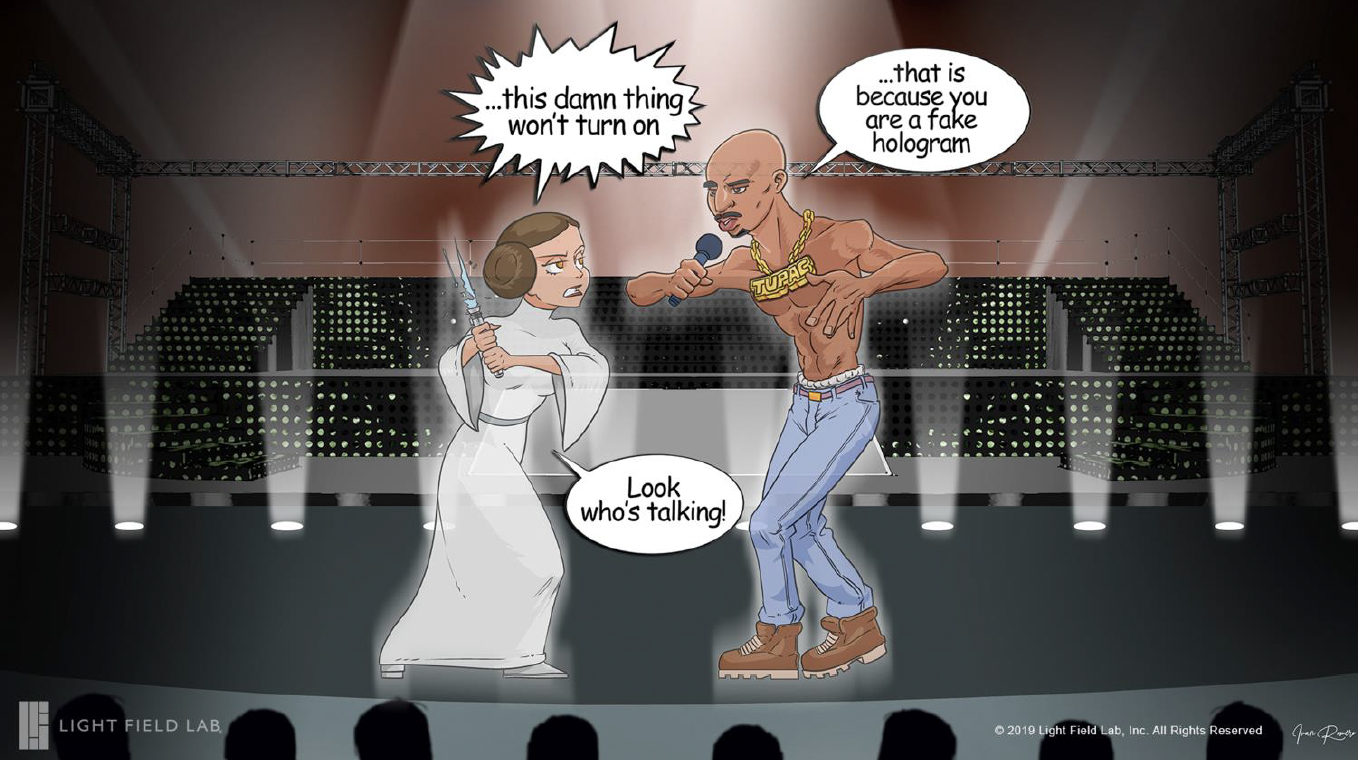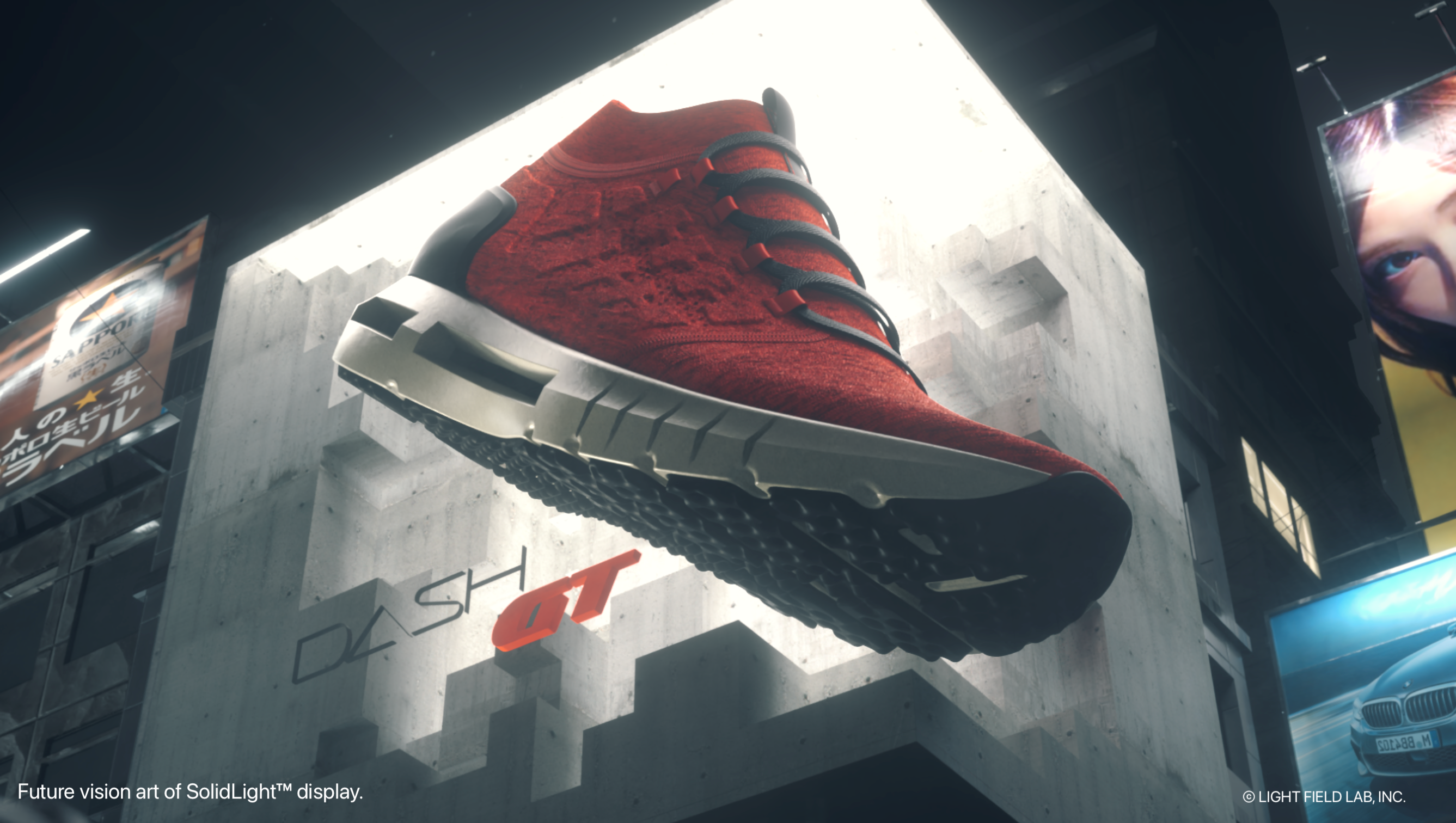The Holographic Dream
Light Field Lab's CEO, Jon Karafin shares his thoughts on what is, and what is not a hologram.

We all think we know what a hologram is. After all, most of us have seen—or at least heard about—virtual objects floating in mid-air, whether it’s Tupac at Coachella or Princess Leia being projected by R2D2 in Star Wars. In fact, neither of these were holograms, and are just two examples of numerous technologies incorrectly marketed that way.

“Real images” as defined by optical physics can be recreated by a holographic display with a massive number of viewing angles of the scene that change with the point of view and location. When a holographic display allows you to see around objects when you move your head in any direction, motion parallax is maintained—the ability to view objects closer to us as moving faster than objects that are further away. When reflections and refractions behave correctly, your brain says, “this is real.” But to achieve this holographic realism, a holographic display must provide high-resolution scene information that changes depending on the viewing angle and location mimicking the real world.
The Eye-line Rule
The eye-line rule, states that true holographic objects can only been seen between the viewers eyes and a light emitting source. Or another way of putting it, everyone’s beloved Princess Leia could not have been seen via R2D2’s magical flashlight (from an optical physics standpoint that is). However, if the floor was a holographic display, the green areas show what would have been possible to see from the actors point of view.
The dream of a real hologram has given rise to a plethora of “good tries but no cigar” technologies claiming to be holographic. A majority of all things you see represented as holographic are actually just variations of other flat 2D display technologies.
A real holographic object can only be seen between the viewer’s eyes and a holographic light source, known as the “eye-line” rule. Science fiction can do the impossible but, unfortunately, physics cannot. All true holographic technologies require a display surface to project holographic light, otherwise the eye-line rule is violated. Anything that suggests otherwise...is just movie magic.
Now to be clear, this is not a judgment against these technologies. Many 2D displays produce great images, and so are the derivatives that come from them. However, they are not holographic. So, how do you to tell a fake hologram from the real deal? If you think you see light magically freezing in mid-air—spoiler alert—it’s a forgery! Below are some of the more popular examples of technologies that, although may be interesting to watch, are not truly holographic.
Pepper’s Ghost
Pepper’s Ghost is an illusion that is popular in carnivals, museums, concerts and theater, which dates back to the mid-1800s when British scientist John Henry Pepper popularized it. Pepper’s Ghost is still going strong. It was used to “resurrect” Tupac at Coachella in 2012 and Michael Jackson at the Billboard Music Awards in 2014, as well as dozens of other posthumous celebrities.
A daily selection of features, industry news, and analysis for tech managers. Sign up below.
In the above examples, the Pepper’s Ghost technique works by reflecting a 2D image off of a piece of semi-transparent film or surface. It’s also one of the roots of the term “smoke and mirrors.” But don’t get taken in. It’s cool, but just as cool as looking at any 2D display...in a mirror...and if you reach out to grab it, you’ll break it.
Example displays that fall into this category include: Vntana, Hologram USA, Musion
Stereoscopic 3D Displays
Stereoscopic 3D Displays are another illusion. 3D movies and 3D TVs rely on glasses to join together two flat images, one for each eye with slightly different viewpoints. There’s no motion parallax and you focus incorrectly on the screen because every pixel radiates the same left or right-eye image regardless of viewing angle. In other words, as you move about a stereoscopic display, the perceived geometry literally follows the viewer, resulting in distortions and painful disparities. As human beings, we are in constant motion, even when sitting still, and any lack of micro-parallax change tells the brain that what we are seeing is not real.
Example displays that fall into this category include: RealD, IMAX 3D, many consumer 3D televisions
Glasses-Free 3D Displays
Glasses-Free 3D Displays are a stereoscopic technique otherwise known as horizontal multi-view, parallax-only, or autostereoscopic. These are often dubbed holograms but, at best, these are one-dimensional limited light fields with two or more viewpoints that deliver an illusion of parallax. But this technique doesn’t produce a true object in space nor allow the eye to focus on the image like you would in the real world. This is referred to as the vergence-accommodation conflict and a leading cause of headaches and nausea.
Example displays that fall into this category include: RED’s Hydrogen One Phone, The Looking Glass, Leia (as included within the Hydrogen One)
Augmented Reality/Virtual Reality
Augmented Reality/Virtual Reality are head-mounted displays that can be quite immersive—but they don’t create holograms. AR/VR typically couple two flat images of the scene with motion tracking such that some range of motion parallax may be rendered. However, the limited resolutions, narrow field of view, poor optical quality, lack of opacity handling (for AR), problematic motion latency, and the inability for the eye to truly focus freely about the volume (regardless of marketing claims) detract from a realistic viewing experience. Bottom line: head mounted displays do not project real objects into space.
Further, the separation of content source from display technology is extremely important. While both AR and VR may sample from a holographic dataset when coupled with motion tracking, the technology does not visually present a hologram to the user because they are still only seeing images on flat 2D displays.
Example displays that fall into this category include: Magic Leap*, HoloLens*, Oculus
The Future
After CES 2019, Fortune magazine declared, “Holograms May Finally Be Coming Of Age.” Today, scientists, manufacturers and entertainment companies are already engaged in developing ways to use real holograms.
The future is here, and Light Field Lab is beyond excited to help build this holographic future together.
Note: *Some displays leverage technologies called Holographic Optical Elements (HOEs). Even though these elements are produced through holographic means, this does not classify them as a holographic display for all of the reasons stated throughout this article.
RELATED
>> Highest Resolution Holographic Display Platform Unveiled
>> Light Field Lab Raises $28 Million Series A to Build Holographic Ecosystem
>> ICRWorlds Holographic Display Releases Forecasts
>> How AR/VR Can Elevate Learning Experiences
>> Frost & Sullivan Touts AR/VR as Future of User Interfaces
The staff of AV Technology serves the community of decision-makers comprising AV/IT technology managers and directors, instructional technologists, and anyone making or influencing AV/IT technology decisions within their respective facilities and institutions.
